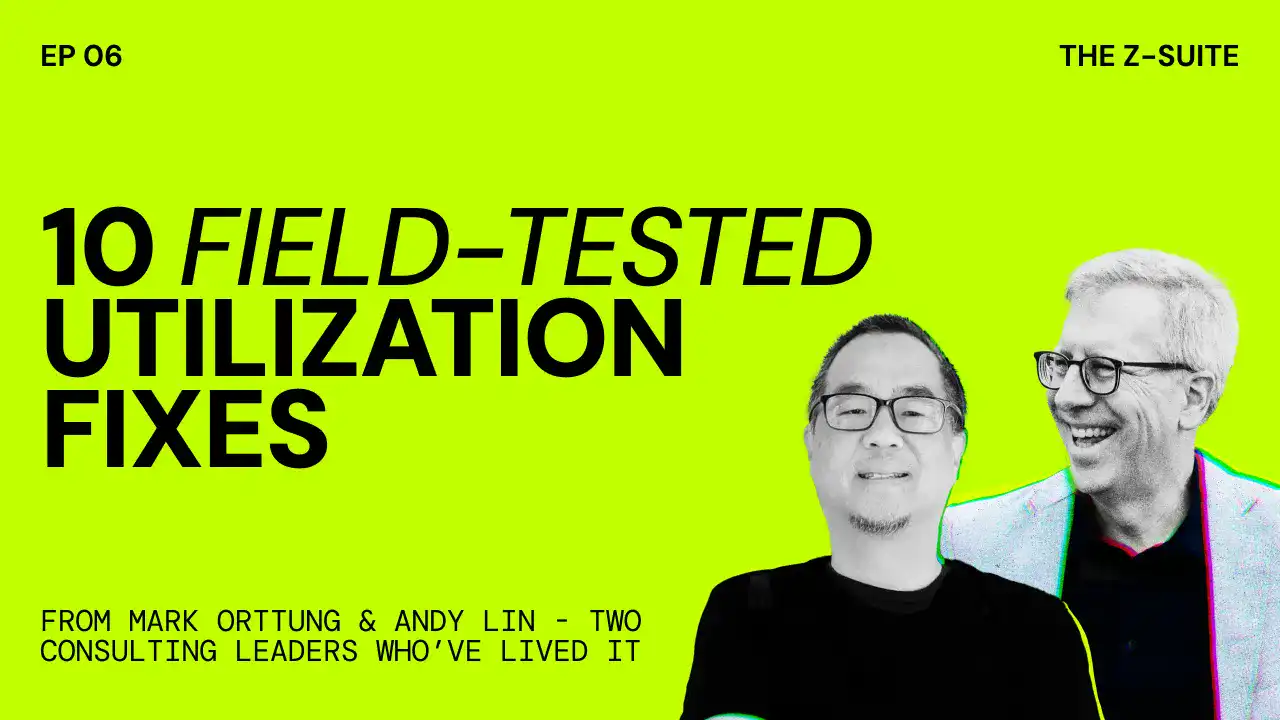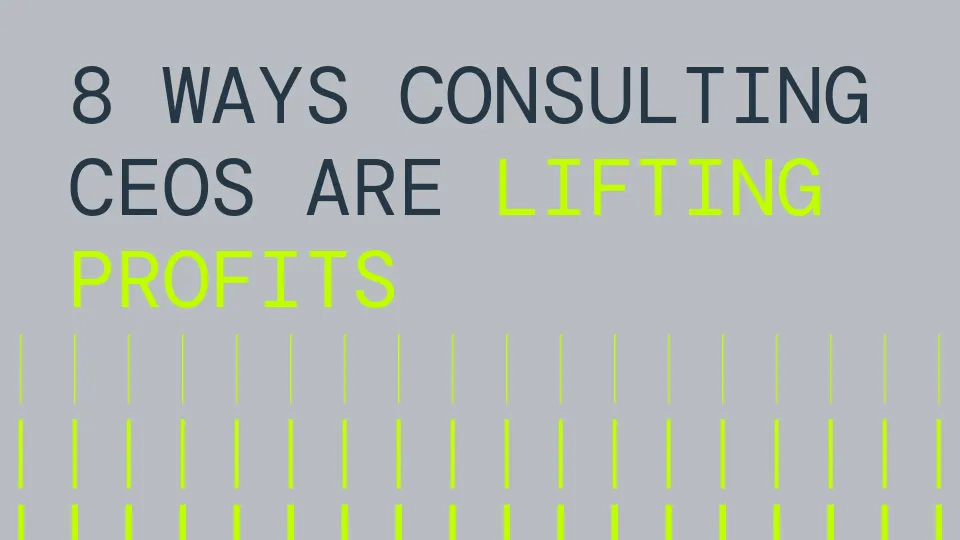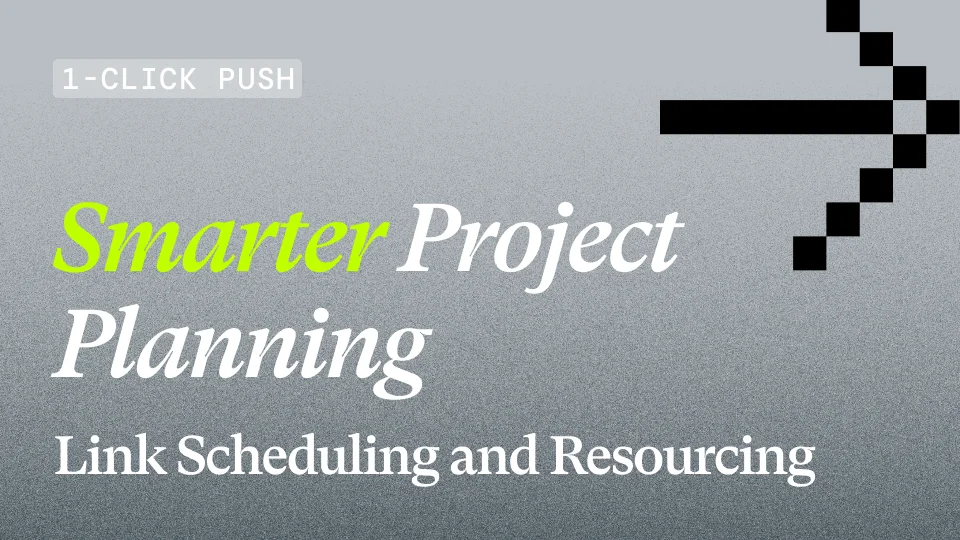10 Field-Tested Utilization Fixes from Leaders Who’ve Lived It

Most firms treat utilization like a thermostat. Too cold, crank it up. Too hot, hope nobody burns out. The reality is messier. Hours leak in the handoffs, decisions drift, heroes hoard the hard work, and a quiet three-week gap nukes a quarter.
You don’t fix lumpy utilization with a new project and resource management policy. You fix it by treating utilization like a system, not just a number.
The firms that win at this stuff project that actually bills, kill the idle time hiding between phases, and resource their smartest people to share load instead of hoarding it. And the firms that’ll win at it tomorrow - they’re already using AI as a productivity multiplier - running hybrid teams, flattening their org charts, and hitting 110% as a result.
Here are Mark Orttung and Andy Lin’s ten utilization-lifting moves, pulled straight from their live conversation in the Z Suite. They’re two consulting leaders who’ve lived it - watch the full conversation below, or scroll down for their field guide.
1) Mind The Gaps Between Project Phases
Three slow weeks between phases will wreck a quarter faster than three slow months in the pipeline. The drift can feel inevitable: decisions hang with the client, your team sits on the bench, or they scatter to low-margin tasks that are hard to unwind when the client is finally ready.
What great firms do: They operationalize “gap prevention” 2-3 months ahead. Project delivery leads forecast pauses in project timelines, work with clients to close or fill them, and make sure the extra work equals margin, not scope creep. Good resource management software will surface the gaps faster, while a good project delivery lead will have already spotted the client opportunities to fill them - make sure your firm has both.
“Clients often don’t appreciate the difficult position they’re putting you in as a consulting firm. To them it feels like a small ask to ‘just hold the team for me for four weeks’ - but a consulting firm running a pretty classic margin would need to work another three months just to break even on that four weeks that the team sat idle. Once they get it, they’re more willing to work with you on getting a decision and not having a gap.”
- Mark Orttung, Projectworks CEO
2) Don’t Over-Resource Your Heroes
Lumpy utilization isn’t just dragged down by your under-resourced 60%-ers. Paradoxically, it can often be caused by a project and resource management strategy that over-utilizes your heroes - the consultants who tend to run at 120% on every project. Sure, they do a stellar job of shouldering an oversized load, but the downstream impact is a few projects with incredibly high utilization rates, and a low overall rate across the firm.
What great firms do: They coach their A-Players to distribute their work, by shifting their definition of success from just a small handful of projects or clients, to the whole firm. Project and resource management success metrics like margin and revenue confidence that celebrate the collective effort, rather than the effort of just your heroes, can be really powerful here. The payoff is more heroes, happier clients, and a more consistent utilisation rate across projects.
“Your A-Players get a kick out of being the hero. And there’s nothing wrong with that - we want all of our consultants to care that much. But one of the things that we’re coaching them on is bringing in some of the less utilized people to do some of the work. Because unless you want to put in 150% on every single project, forever, in the long-run you need to bring others in to shoulder some of that heroic load.”
- Andy Lin, Provoke CEO
3) Resource To A Healthy Rate - Then Boost It With AI
Many consulting leaders pick utilization targets by gut-feel, then end up burning people out or compromising on quality. Worse, they use that same gut-feel to measure utilization rather than real-time resource management software, and miss the small pockets of under-utilization that over time end up being your biggest profit leaks.
What great firms do: They set data-informed utilization targets, report on them in real-time, then revisit them quarterly. As AI continues to shake up the consulting industry, utilization and margins will become ever-more volatile, so calibrate to current reality, not last year’s plan. And make sure you’re building an AI tech stack that sets your team up for a 10% utilization lift a year from now - without the same lift in headcount.
“If you are lucky enough to have a really high-value services firm and can justify really high bill rates today, you might have the luxury of a 75% - 85% utilization rate. If you are a little lower towards commodity you might run a much higher utilization rate. Regardless, I think all of that shifts up with AI - your future utilization rate will be now plus 10%.”
- Mark Orttung, Projectworks CEO
4) Get Everyone Selling - No Matter What Their Job Title Is
If you don’t have enough work for the team you have, it doesn’t matter how good your project and resource management systems are - you’re going to have a utilization problem. This all gets easier if you sell more work, and often the people in your team best-placed to spot and sell more work are the ones who’d never think of themselves as salespeople.
What great firms do: They don’t think about sales as roles or quotas. They expect everyone in their firm to think - and operate - like an owner. Make your low utilization rate feel like everyone’s problem to solve, not just yours, by expecting all consultants to be your new business radar - regularly spotting opportunities for new work, not just delivering the projects they’re on.
“Getting everyone on the team selling is key. Your frontline consultants, the ones working with the client day-to-day, they they have the best seat to figure out where there’s other work. Even if they’re not comfortable being salespeople, have them be your eyes and ears, bringing opportunities back to somebody who is comfortable pursuing it with the client, making an unsolicited proposal or an ask for work.”
- Mark Orttung, Projectworks CEO
5) Hold Your Niche, Even When Your Pipeline Says Otherwise
When the pipeline’s empty that temptation to say yes to all and any work is strong - anything to get your bench back to work, and cash flowing. Stretching beyond your expertise for a month or two might feel like the right call at the time, but long-term it’ll create new skills gaps you’ll have to hire for - which will end up pushing down your utilization for quarters, or even years to come.
What great firms do: They protect specialization because it raises win rates, keeps headcount lean, and improves pricing power. While saying no to work outside your core niche can feel like the riskier move in quieter times, holding that focus is your firm’s best utilization stabilizer.
“You’ve gotta niche down. You’ve got to say here is who we are, here is what we’re gonna focus on. Because saying yes to anything out of the bounds of your speciality will force you to do all sorts of unnatural things - go and find an expert in a skillset you don’t already have in house - you want to avoid that.”
- Andy Lin, Provoke CEO
6) Grow - And Resource - New Skills From Within
Hiring for every new tool or client ask leaves you with partial benches and slow time to bill. It also signals to your team that growth means leaving, not learning.
What great firms do: They know their best consultants aren’t the deepest narrowest experts, they’re the fastest learners - and they hire and promote their people accordingly. Next time you hit a skills gap in your next project resource management meeting, avoid the temptation to fill it with a new hire - instead find the consultant in your team that has 3 out of 5 of the required skills, then coach them to pick up the other skills on the project, while also handing over the easy stuff to AI.
“Part of that specialness of being a consultant is our ability to learn fast, make connections, leverage the skills and experience we have to transfer and develop a new skill that we might not have completely within our grasp to apply to a project. The best consultants are the ones who might have say three out of the five requisite skills, and the two skills they develop as part of doing the project”
- Andy Lin, Provoke CEO
7) Build A Team That Can Stretch With Your Project Pipeline
Consulting is unpredictable - next quarter’s projects suddenly get greenlit overnight, while urgent projects get stuck in budget approvals for months. Even the most advanced project resource management tool won’t get you to 100% utilization - to do that you need humans who can occasionally stretch to absorb the project peaks.
What great firms do: They hire consultants who get a kick out of helping their clients succeed, and will stretch beyond 100% utilization to make it happen. They also teach their senior leaders to harness that stretch responsibly - deploying it for occasional short-term spikes only, rather than relying on it as a long-term project and resource management strategy.
“Find consultants that derive their dopamine from seeing clients succeed. If that’s part of their being, then occasionally when there’s a few weeks where they need to work a few extra hours you can count on those people to step up, and perform that work, and do it well. Of course you can’t do that for long, but for short bursts I’ve found if you’ve hired the right people they’re more than capable, and more than willing to stretch themselves, while still delivering at a high quality because they just care so much about the client’s success.”
- Andy Lin, Provoke CEO
8) Choose Fast Learners Over Deep Experts
Traditionally, a firm’s most in-demand consultants have been their senior experts - seasoned - and narrowly focused - specialists. As AI forces every consulting firm to reinvent itself - and its skills mix - every few months - that’s shifting. A year from now your firm’s A-Players will be its hungriest learners - the consultants most comfortable learning new things at the speed of AI.
What great firms do: They recruit and reward learning velocity, rather than established expertise, then resource people out on the edges of their comfort zone to force skills growth across the entire firm.
“The people who are your life-long learners, they’re the best people to have on your team because they’ve already gotten themselves through bootcamp, they’ve taught themselves how to code - whatever the next thing is they’re going to teach themselves how to do that as well.”
- Mark Orttung, Projectworks CEO
9) Utilization Isn’t Just About Human Productivity Any More
Leaders who’ve maintened high utilization rates have typically done so by focusing just on human productivity - get your people doing more billable work with the hours they have, and your utilization rates go up. With the rise of agentic AI, it’s not just about human productivity anymore.
What great firms do: They’re shifting their project and resource management conversations from ‘who’s the right human for the job' to ‘what’s the right human-AI mix for the job', and upskilling their leaders to get the very most out of both their human and digital workers.
“Anything that you can describe on a workflow or flowchart - you can probably hand that over to an AI agent and have a high degree on confidence that an agent is going to perform that work at a velocity that humans just can’t beat. As consulting moves to more hybrid teams, where you have humans doing the work alongside tech agents or digital co-workers, that ability to manage hybrid teams is going to be a new skill that consultants, especially leaders in consulting, are going to need to learn how to do. Just managing the team is no longer going to be sufficient.”
- Andy Lin, Provoke CEO
10) Flatter Org Chart = More Productive Firm
As AI steps in to take over the busy work, clients are rethinking what they’re willing to pay for - and it’s not layers of leadership, or mountains of juniors. The days of hands-off project leadership are over. Your firm's most senior people now need to be on the tools and in the rooms - doing the work themselves, rather than just handing it off to junior consultants.
What great firms do: They’re shifting from a traditional consulting pyramid, to a much flatter one, where AI replaces grunt work of juniors, and seniors own the deeply human stuff - diagnosing the real problem, and building consensus around a solution.
“A firm’s hierarchy is going to become a friction point to keeping up with the speed of AI, so you’re going to see flatter organisations. We’ll still need senior humans, but clients are going to everybody on their project teams to do more hands-on work. They’ll want hands-on leaders, not just people who sit back and push paper around.”
- Andy Lin, Provoke CEO
A Consistently High Utilization Rate Isn’t A Fantasy - It Just Takes Practice.
It’s the compound effect of boring, disciplined moves that remove the small leaks that sink good firms. Your bench gets emptier when gaps are forecast and prevented. Peaks flatten when you stop bottlenecking around your heroes. Utilization targets get hit - then surpassed - when AI is part of the workflow, not an experiment in the corner.
Regardless of which utilization play you run in your firm first, the common lever is visibility. Without a clear line of sight to WIP, margin, forecast, and cash, even good leaders guess wrong. If your resource management software isn’t delivering that, start by booking a demo.
Related Articles

8 Ways Consulting CEOs Are Lifting Profits - With Help From Resource Management Software
If your project and resource management lives in spreadsheets, everyone feels the drag - including your profits. Proposals wobble because you’re guessing who’s free. Delivery slips because project planning isn’t keeping up with project realities. Some teams are overloaded while others wait for work. It’s frustrating, it’s expensive - and it’s fixable.

